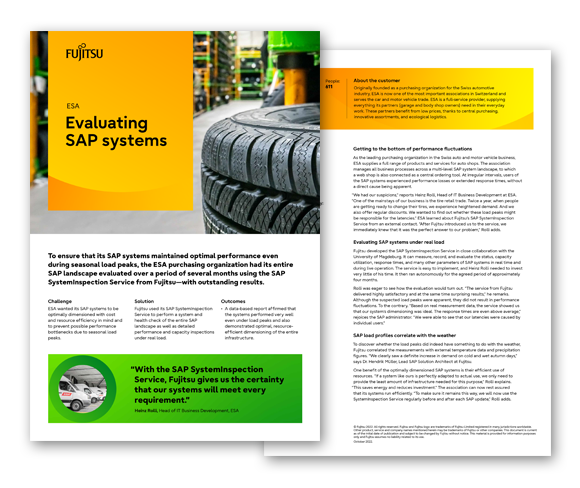To ensure that its SAP systems maintained optimal performance even during seasonal load peaks, the ESA purchasing organization had its entire SAP landscape evaluated over a period of several months using the SAP SystemInspection Service from Fujitsu—with outstanding results.
Challenge
ESA wanted its SAP systems to be optimally dimensioned with cost and resource efficiency in mind and to prevent possible performance bottlenecks due to seasonal load peaks.
Solution
Fujitsu used its SAP SystemInspection Service to perform a system and health check of the entire SAP landscape as well as detailed performance and capacity inspections under real load.
Outcomes
- A data-based report affirmed that the systems performed very well even under load peaks and also demonstrated optimal, resource-efficient dimensioning of the entire infrastructure.
With the SAP SystemInspection Service, Fujitsu gives us the certainty that our systems will meet every requirement.
Heinz Rolli, Head of IT Business Development, ESA

98%
of the dialog steps demonstrate good performance quality: an excellent result.
- Industry: Automotive
- Location: Switzerland
- People: 611
- Customer's website

About the customer
Originally founded as a purchasing organization for the Swiss automotive industry, ESA is now one of the most important associations in Switzerland and serves the car and motor vehicle trade. ESA is a full-service provider, supplying everything its partners (garage and body shop owners) need in their everyday work. These partners benefit from low prices, thanks to central purchasing, innovative assortments, and ecological logistics.
Getting to the bottom of performance fluctuations
As the leading purchasing organization in the Swiss auto and motor vehicle business, ESA supplies a full range of products and services for auto shops. The association manages all business processes across a multi-level SAP system landscape, to which a web shop is also connected as a central ordering tool. At irregular intervals, users of the SAP systems experienced performance losses or extended response times, without a direct cause being apparent.
“We had our suspicions,” reports Heinz Rolli, Head of IT Business Development at ESA. “One of the mainstays of our business is the tire retail trade. Twice a year, when people are getting ready to change their tires, we experience heightened demand. And we also offer regular discounts. We wanted to find out whether these load peaks might be responsible for the latencies.” ESA learned about Fujitsu’s SAP SystemInspection Service from an external contact. “After Fujitsu introduced us to the service, we immediately knew that it was the perfect answer to our problem,” Rolli adds.
Evaluating SAP systems under real load
Fujitsu developed the SAP SystemInspection Service in close collaboration with the University of Magdeburg. It can measure, record, and evaluate the status, capacity utilization, response times, and many other parameters of SAP systems in real time and during live operation. The service is easy to implement, and Heinz Rolli needed to invest very little of his time. It then ran autonomously for the agreed period of approximately four months.
Rolli was eager to see how the evaluation would turn out. “The service from Fujitsu delivered highly satisfactory and at the same time surprising results,” he remarks. Although the suspected load peaks were apparent, they did not result in performance fluctuations. To the contrary. “Based on real measurement data, the service showed us that our system’s dimensioning was ideal. The response times are even above average,” rejoices the SAP administrator. “We were able to see that our latencies were caused by individual users.”
SAP load profiles correlate with the weather
To discover whether the load peaks did indeed have something to do with the weather, Fujitsu correlated the measurements with external temperature data and precipitation figures. “We clearly saw a definite increase in demand on cold and wet autumn days,” says Dr. Hendrik Müller, Lead SAP Solution Architect at Fujitsu.
One benefit of the optimally dimensioned SAP systems is their efficient use of resources. “If a system like ours is perfectly adapted to actual use, we only need to provide the least amount of infrastructure needed for this purpose,” Rolli explains. “This saves energy and reduces investment. ” The association can now rest assured that its systems run efficiently. “To make sure it remains this way, we will now use the SystemInspection Service regularly before and after each SAP update,” Rolli adds.








